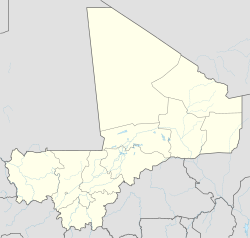History and culture
The town has a long history as a center for Songhay farmers and Bozo fishing communities, as well as settled elements of the semi-nomadic Fula, Tuareg and Maure peoples. Goundam was a city of the Songhai Empire, fell to the Moroccan invasion in 1591, and was later seized by Tuareg confederations from the northeast and the Fula of the delta region. Most powerful of these Fula states was the Macina Empire, centered to the southwest. The Toucouleur Empire conquered the area in the mid 19th century, and the French captured the town in 1894. [4]
French conquest
Goundam was the site of a major reverse in the French drive to Timbuktu, known at the time as the "Goundam Massacre". In December 1893 French lieutenant colonel Eugène Bonnier took a small company of troops downriver from the French outpost at Segou to conquer Timbuktu on his own initiative. His advance guard, an even smaller force of two gunboats commanded by Lieutenant H. Gaston Boiteaux, went ahead, but contrary to their orders advanced to Timbuktu themselves, beating out Bonnier. Bonnier pursued him, finding Boiteaux had taken the fabled city prior to the Lt. Col's arrival on 10 January 1894. That day, after arresting his subordinate, Bonnier marched out towards Goundam with a small number African troops. They took the town 14 January, but on the way they had seized 500 sheep at a Tuareg encampment, and fought Tuareg raiders at nearby Tacoubao. In the early hours of 15 January, Tuareg warriors attacked Bonnier's camp, killing him, 11 officers, two French NCOs, 68 African Tirailleurs, and their interpreter. A rescue column, commanded by the future Marshal of France Joseph Jacques Joffre, recaptured Goundam on 8 February and Timbuktu four days later. [5]
Refugee center
In the period following the Sahel droughts of the 1970s, and again following the 1990s Tuareg Rebellion, Goundam became a major relocation center for Tuareg and other refugees from the north of Mali. Many still remain around Goundam town. [6]
This page is based on this
Wikipedia article Text is available under the
CC BY-SA 4.0 license; additional terms may apply.
Images, videos and audio are available under their respective licenses.

